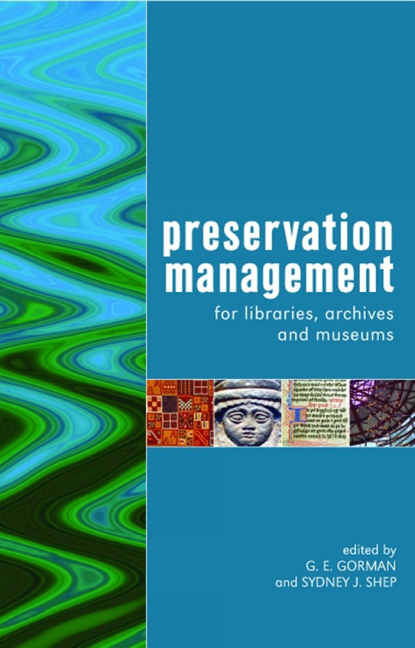Book contents
- Frontmatter
- Contents
- About the contributors
- Introduction
- 1 Managing the documentary heritage: issues for the present and future
- 2 Preservation policy and planning
- 3 Intangible heritage: museums and preservation
- 4 Surrogacy and the artefact
- 5 Moving with the times in search of permanence
- 6 Valuation model for paper conservation research: a new approach for setting research priorities
- 7 Preservation of audiovisual media: traditional to interactive formats
- 8 Challenges of managing the digitally born artefact
- 9 Preserving cultural heritage in times of conflict
- 10 Access and the social contract in memory institutions
- 11 Redefining ‘the collection’ in the 21st century
- Index
7 - Preservation of audiovisual media: traditional to interactive formats
Published online by Cambridge University Press: 08 June 2018
- Frontmatter
- Contents
- About the contributors
- Introduction
- 1 Managing the documentary heritage: issues for the present and future
- 2 Preservation policy and planning
- 3 Intangible heritage: museums and preservation
- 4 Surrogacy and the artefact
- 5 Moving with the times in search of permanence
- 6 Valuation model for paper conservation research: a new approach for setting research priorities
- 7 Preservation of audiovisual media: traditional to interactive formats
- 8 Challenges of managing the digitally born artefact
- 9 Preserving cultural heritage in times of conflict
- 10 Access and the social contract in memory institutions
- 11 Redefining ‘the collection’ in the 21st century
- Index
Summary
Introduction
At their 27th Annual Conference, FIAT (2004), the International Federation of Television Archives, formalized an International Appeal for the Preservation of the World's Audiovisual Heritage. In this appeal they called attention to the critically endangered state of much of the world's audiovisual heritage, particularly in less advanced countries, and issued a call for action to professionals everywhere to press for more resources and attention to be paid to this task. With the growing acceptance that audiovisual materials form an essential component of the collective memory for the last 100 years or so, and that the pace of deterioration and technological obsolescence makes it increasingly likely that a large proportion of these items has already been lost forever, this call for action was intended to mobilize all those involved in cultural preservation to lobby for the necessary human and financial resources to give the task the priority it deserved.
For libraries, archives and museums who have a tradition of acquiring the range of audiovisual media on a wide variety of physical formats, this call to action confirms what they already know: that there are problems with preserving and accessing older formats and that the scale of the problem is, in many organizations, daunting. The large collections of photographs, film and audiotape that have been established, together with the less common collections of discs and videotape, are demanding attention now. And while these physical collections pose significant challenges, the new digital formats have added another level of complexity to the preservation issue that calls for ‘new ways of thinking about preservation, and new skills’ (Harvey, 2004, 1).
Much has been written about the long-term management of the physical media and this chapter will provide a broad overview of preservation practices that most institutions, lacking highly specific and dedicated resources for audiovisual preservation, can adopt in order to prolong the life of this material. For the emerging digital objects and their preservation needs, the situation is less clear and discussion will centre upon broad approaches to dealing with these new collections.
- Type
- Chapter
- Information
- Preservation Management for Libraries, Archives and Museums , pp. 97 - 116Publisher: FacetPrint publication year: 2006

